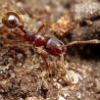First journal! Nabbed a small two queen colony from under a rock and then brood boosted them with pupae. I ave them housed in a petri dish full of dirt. They dragged all the pupae and 1 larvae into a cavity in the center. I've never kept a ponerine species before so I need help.
- Formiculture.com
- Forums
- Gallery
- Members
- Member Map
- Chat


















